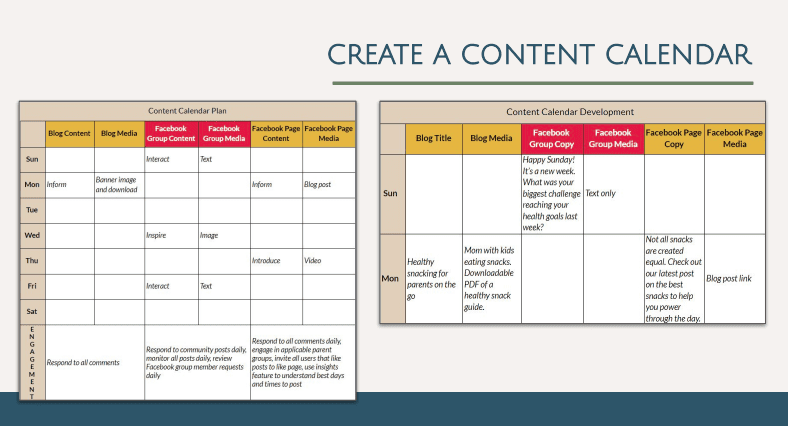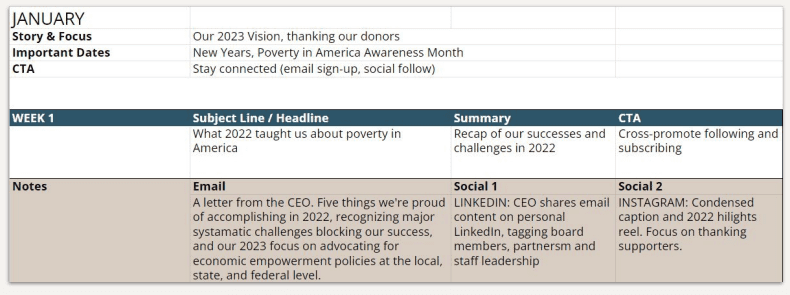We’ve all been there: staring at a blank screen, desperately trying to create captivating social media fundraising content that resonates with our audience, while keeping up with the latest algorithms and trends.
It can feel like a daunting task but it’s necessary. In a world where billions of people spend hours each day scrolling through their news feeds, social media is ripe for cultivating generosity. From the Ice Bucket Challenge that took the internet by storm to Growing a Mo for men’s health, when something catches on, it can lead to a chain of impact worldwide.
So, are you ready to harness the power of social media for your fundraising efforts? While incorporating insights provided in our webinar with Maria Bryan, we’ll demystify the content planning process, discuss trauma-informed storytelling, unpack resources, and help you create content that converts.
About the Presenter
Maria Bryan is a nonprofit marketing and messaging strategist with more than fifteen years in the communications and marketing sector. She’s certified in trauma and resilience and holds the core belief that storytellers play an incredible role in making the world a healthier, safer, and happier place.
The Importance of Storytelling
It’s no secret that a great story can generate movers and shakers. By taking a step back and shifting your mindset to see your social media and fundraising content as storytelling, you have the potential to drive action and change the trajectory of where people choose to commit their wallets.
Setting Goals & Identifying Your Audience
Goals & Objectives of Your Social Media Content
While you’re in the process of figuring out your social media fundraising goals, let’s explore some common campaign objectives. These goals serve as a North Star, helping you direct their efforts and shaping the content you create.
- Increasing Donor Engagement: By creating engaging content, you can encourage engagement, spark conversations, and build a dedicated following around your cause.
- Expanding Your Donor Base: One of the key benefits of social media is its unparalleled ability to reach new audiences. Leveraging targeted ads, strategic partnerships, and compelling storytelling, you can attract potential donors who align with your organization’s mission and vision.
- Reaching a Specific Fundraising Goal: By creating persuasive content that highlights the impact of donations and providing clear calls-to-action, you can inspire individuals to contribute to your cause.
- Raising Awareness: Sometimes, the greatest obstacle to fundraising is a lack of awareness. Social media offers a prime opportunity to educate your audience, dispel misconceptions, and inspire a deeper understanding of your work.
- Cultivating Brand Identity: Your nonprofit has a unique identity and story to tell. Build a strong, credible brand identity with consistent messaging, powerful visuals, and a compelling narrative.
Remember, these objectives are not mutually exclusive, and your social media strategy may encompass multiple goals simultaneously. The key is to define clear, measurable objectives that align with your overall fundraising strategy and tailor your content to support those goals.
Identify Target Donor Audience & Platforms
To create impactful social media content, it’s crucial to have a deep understanding of your target donor audience. By gaining insights into their motivations, interests, and behaviors, you can tailor your messaging and select the best platforms for reaching and engaging them. Here’s why understanding your audience is essential for successful social media fundraising:
- Relevance and Connection: When you’re truly attuned to your donor’s interests and preferences, you can create content that resonates with them on a personal level.
- Efficient Resource Allocation: Your time and resources are limited, so it’s essential to invest them wisely. By identifying your target donor audience, you can focus your efforts on the platforms where they are most active.
To pinpoint your target donor audience, consider the following strategies:
- Analyze Existing Donor Data: Start by reviewing the data you already have. Look for patterns, demographics, and behavioral insights of your current donor base. This information can provide valuable clues about the characteristics of individuals who resonate with your cause.
- Conduct Surveys and Interviews: Deepen your understanding by engaging directly with your donors through surveys, interviews, or focus groups. Seek their feedback, ask about their motivations for supporting your organization, and gather insights into their platform preferences.
As always, different social media platforms cater to different user demographics. Consider the following platforms for reaching and engaging specific donor segments:
- Facebook: With nearly three billion users worldwide, Facebook remains a powerhouse for reaching a wide range of donor segments. While the platform’s user base runs the gamut in terms of age, it’s most useful for reaching an older demographic.
- Instagram: This visually-driven platform attracts a younger audience, making it a great choice for nonprofits targeting millennials and Gen Z donors.
- LinkedIn: LinkedIn is best for corporate or professional donors. It provides a space to build relationships with professionals, showcase your organization’s expertise, and explore potential partnerships.
Remember, these are just a few examples, and the platforms you choose to prioritize should align with your specific goals and target audience.
Building Out Your Content Calendar
Consistency is the bedrock of successful social media outreach, and a well-planned fundraising calendar is the key to achieving it. By mapping out your content in advance, you ensure a consistent presence on your supporters’ feeds while maximizing the impact of your messaging to align with specific campaign timelines. For example, by creating content specifically tailored to Giving Tuesday or year-end giving, you can leverage the momentum of these events to drive donations.

To create a well-planned fundraising calendar, consider the following tips:
- Define Clear Fundraising Goals: Start by identifying your specific fundraising goals for each campaign or time period. Whether it’s raising a certain amount of funds, acquiring new donors, or promoting a specific initiative, your calendar should be built around these objectives.
- Map Out Campaign Timelines: Determine the start and end dates of your fundraising campaigns, and break them down into key phases. Be sure to assign specific actions to each phase.
- Identify Critical Dates: Highlight important dates related to your cause, such as Giving Tuesday, holidays, or awareness days. Incorporate content tailored to these dates into your calendar to capitalize on the increased attention and engagement during these periods.
- Use Different Kinds of Content: Plan a variety of content types to keep your social media presence dynamic and engaging. Include a mix of storytelling, visuals, videos, testimonials, and calls-to-action.
- Schedule Regular Engagement: Set aside time to engage with your audience through comments, messages, and shares. Actively participating in conversations shows your supporters that you value their input and fosters a sense of community.
Start with a Year Overview

One of the best tips Maria provides is to break your calendar down into a year overview.
A year overview provides a comprehensive snapshot of the upcoming year, allowing you to plan your fundraising activities strategically. This includes what Maria calls “warm-up” months. Starting in February (and again in August), these months serve as a “warm up” phase from a fundraising perspective. Instead of making financial asks, this period focuses on cultivating your audience as well as sharing the problems you aim to solve and highlighting the impact you have made.
Of course, during the warm-up months, you shouldn’t forgo calls-to-action entirely. It’s still important to include calls-to-action that encourage engagement. For instance, you can invite people to follow you on social media or subscribe to your newsletter. These smaller requests help foster ongoing interaction and maintain a connection with your audience. By gradually building a relationship and consistently sharing valuable content, you create a receptive environment that increases the likelihood of a positive response when you do make a larger ask.
Once you have your year overview, drill down further by breaking our your year into months:

Come up with Content Buckets

Organize your content by categorizing it into thematic groupings-“buckets”-that help you maintain a balanced and engaging social media presence. Here are some key content buckets to consider:
- Entertain: Share lighthearted content that entertains your audience. This could include memes, videos, or quizzes that provide a break from serious topics while still aligning with your cause or mission.
- Inspire: Uplift your audience with inspiring content such as success stories, impactful quotes, or empowering messages that encourage your supporters to take action.
- Introduce: Provide a personal touch by highlighting a staff member or volunteer who has made a significant contribution to your organization. Alternatively, showcase behind-the-scenes footage of your staff in action, giving your audience a glimpse of the work you do.
- Inform: Position your organization as a trusted source of information by educating your audience. Share an infographic that breaks down complex information into easily digestible visuals or post an article discussing the latest developments in your field.
- Interact: Foster engagement with your audience through content that invites participation. Ask questions, conduct polls, or run contests to encourage feedback. Responding to comments and messages also helps create a space for conversation and connection.
- Update: Create transparency by keeping your supporters in the loop with updates about ongoing campaigns, fundraising progress, or upcoming events.
- Call-to-Action (CTA): Encourage your audience to take specific actions that support your fundraising goals. This could include donating, volunteering, signing up for newsletters, or sharing your content.
Pro Tip: Remember to balance your content types and mix them strategically throughout your calendar to maintain variety.
Use a Calendar and/or Scheduling Tool
If you’re managing social media across multiple platforms, it can get pretty overwhelming. It feels like there’s always something to do, and it’s easy to get lost in the chaos.
To stay on top of your social media fundraising content, use a calendar or scheduling tool. Think of it as your personal assistant, keeping everything in order and ensuring you never miss a beat. With the ability to schedule in advance, say goodbye to frantic last-minute posting or remembering to publish updates.
But it’s not just about organization and convenience. You want to know if your efforts are actually paying off, right? Scheduling tools let you monitor the progress of your campaigns, track engagement metrics, and measure the impact of your social media efforts.
With a plethora of calendars and scheduling tools available, it can be overwhelming to make a choice. To get your started, here’s a few we recommend:
1. Google Sheets/Google Calendar
Keeping track of various documents and your team’s schedule can get tricky. With Google Sheets and Google Calendar, collaborate with team members, track important dates, and easily share your calendar – all for free and in real-time.
2. Meta Business Suite
Meta Business Suite is a one-stop shop where you can manage all of your marketing and advertising activities on Facebook and Instagram. Available on desktop and mobile, Meta Business Suite makes it easy to schedule posts, view insights, and respond to messages.
3. Buffer
Buffer allows you to schedule and publish posts across various platforms, providing detailed analytics to measure engagement and campaign performance. While Buffer offers a free plan for individuals and businesses getting started with social media, additional features do cost.
4. Hootsuite
Hootsuite allows you to manage multiple social media accounts, schedule posts in advance, and track metrics to assess the effectiveness of your fundraising campaigns.
To get started, sign up for a 30-day free trial of their team plan. However, once the trial period is over, you’ll need to start paying for ongoing access.
Developing Your Content Strategy
Bringing it back to storytelling, let’s illustrate how you can develop your content using a story arc framework.
Crafting Your Story Arc: Solving The Issue
Think of a story arc as a roadmap for captivating storytelling. It starts by introducing a problem that deeply resonates with a specific group of people. As the story unfolds, your audience can feel the pain and struggles. However, there’s a glimmer of hope—a unique solution emerges, bringing about a transformative change. The story concludes with aspirations for the future, leaving your audience inspired and eager to get involved. It’s like taking them on an emotional rollercoaster ride.
Using a Story Arc Framework
When it comes to social media fundraising, Maria is a big believer that harnessing the power of storytelling with a story arc framework can have a profound impact on engaging your donors. Drawing inspiration from brands like Pixar and StoryBrand, you can apply their storytelling techniques to your social media strategy.
StoryBrand emphasizes the importance of honing your message and crafting a compelling narrative that resonates with the desires and challenges of your donors. Similarly, the Pixar Pitch formula, featuring relatable characters, problem-solving, and transformative journeys, can be a potent tool for creating impactful and memorable social media stories that leave a lasting impression on your followers. By incorporating these storytelling frameworks, you can elevate your social media content and forge a deeper connection with your donors.
Crafting Your Posts
In addition to using your calendar, content buckets, and story arc, here are some things to keep in mind as you craft each post.
Marketing Rule of One
Whether you’re planning social media, a webinar, or a podcast, try to follow Maria’s “ Marketing Rule of One”. When you’re creating something, you should:
- Have 1 audience member in mind
- Convey 1 message
- Tell 1 story
- And end with 1 call-to-action
Remember, you don’t need to reach everyone at once or have several calls-to-action at once. Simplify the content you create and make sure everything you publish is intentional. Keep things clear and focused for your audience. As Donald Miller, founder of StoryBrand says, “if you confuse, you lose.”
Always Use a CTA
Remember to always include a clear call-to-action. What do you want your audience to do? These can link your posts back to your campaign or donation page.
Use Different Kinds of Content
Another thing Maria highlights is that when it comes to social media fundraising, compelling content is the key to capturing the hearts of potential donors. By incorporating various types of content into your posts, you can create a multi-dimensional experience that resonates. Here are some essential elements to consider when crafting social media posts:
- Impact Stories: Donors want to know that their contributions will make a meaningful impact. By sharing stories that demonstrate the positive outcomes of your work, you inspire potential donors with a sense of purpose.
- Visuals that Speak: Utilize captivating images and infographics that depict the essence of your cause and the individuals you serve.
- Engaging Videos: Create compelling videos that tell stories, showcase your projects in action, or feature testimonials from those directly impacted by your work.
- Testimonials and Social Proof: Share testimonials that highlight positive experiences from donors, volunteers, or beneficiaries. Doing this adds credibility (aka social proof) and authenticity to your organization’s work.
Content Batching
For a time-saving approach to managing your social media presence, consider batching your content
Content batching involves creating and scheduling multiple posts in one sitting, allowing you to streamline your workflow, save time, and gain a holistic view of your social media calendar. By dedicating focused periods to create and schedule content in advance, you can maintain consistency, improve organization, and maximize the impact of your social media outreach. So, carve out some dedicated batching time and enjoy a smoother, more efficient social media workflow.
Ethical & Trauma-Informed Storytelling Practices
Bringing a trauma-informed lens into nonprofit marketing is a passion for Maria. While it’s essential to address the pain points and challenges your organization aims to solve, remember to maintain an inspirational tone when highlighting your solution.
She explains that in order to put together a storytelling process that understands, honors, and protects story owners, it begins by:
- Understanding that your clients and beneficiaries don’t owe you their story, no matter how generously your organization has supported them. It’s not quid pro quo.
- Making sure you have informed and enthusiastic consent. Story owners should be allowed to withdraw their story anytime.
- Allowing for plenty of space after people have closed the transformation loop before asking them to tell stories.
- Getting program staff involved who work directly with your clients. Create a client story-gathering protocol and workflow.
- Allowing for control, choice, boundaries, and autonomy during interviews. Create space for people to reschedule, take breaks, or end a conversation if needed, no questions asked.
As communicators and storytellers, we don’t want to skirt around the pain, but we can avoid proverbially twisting the knife by ensuring that our messaging respects the experiences of individuals involved.
Unleash Your Social Media Fundraising Potential
And there it is! While we’ve covered valuable insights and practical tips to elevate your social media game, there’s a treasure trove of additional tips and tricks waiting to be discovered.
To dive deeper into resources like editorial calendars, social media calendars, marketing production calendars, and key messaging points, we invite you to explore the full webinar. Trust us, it’s a goldmine of knowledge and inspiration for your fundraising journey.
And to get more articles like this + tips for nonprofit fundraising in your inbox every week, sign up for our weekly nonprofit educational newsletter.
Editor's Picks
Ultimate Guide To Peer-to-Peer Fundraising
Customer Story: Spur Local Raises Over $1M With Their Give Local Campaign
Fundraising Strategies for Nonprofits: Craft the Best Approach for Your Organization
Create a Killer Fundraising Plan - Best Practices, Strategies, & Downloadable Template



